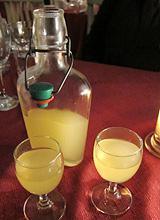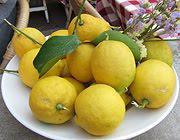 Limoncello (pronounced: lee-mon-chel-low) is a sweet lemon-flavored liqueur made by soaking lemon peel in pure alcohol to extract its aromatic oils. Straight chilled limoncello is served after dinner as a digestive, or to accompany a dessert. When mixed with tonic water or sparkling white wine, limoncello can also make for a refreshing aperitif.
Limoncello (pronounced: lee-mon-chel-low) is a sweet lemon-flavored liqueur made by soaking lemon peel in pure alcohol to extract its aromatic oils. Straight chilled limoncello is served after dinner as a digestive, or to accompany a dessert. When mixed with tonic water or sparkling white wine, limoncello can also make for a refreshing aperitif.The origins of limoncello
Lemons made their first entrance in the Mediterranean region as early as 100 BCE. Around 1000 CE cultivated lemon trees were common in Italy, especially in the regions of Sicily, Calabria, Campania, Sardinia and Liguria. Despite the availability of lemons and a proven Italian tradition in liqueur production, it took until the beginning of the 20th century for limoncello to be invented. The exact birthplace is unknown, with many of the areas renowned for its production claiming its paternity. These include:
- The Sorrento peninsula and the island of Capri. The liqueur is officially called "Liquore di Limone Di Sorrento IGP" (though the name Limoncello is commonly used), made exclusively with "Limone di Sorrento IGP" (Protected Geographical Indication).
- The Amalfi Coast, e.g.: "D'Amalfi Limoncello IGP Russo"(also of Protected Geographical Indication).
- Riviera delle Palme (western Liguria), though the liqueur generally goes under the name 'limoncino'. 'Arancino' (a similar liquor made with oranges) and 'Crema di Limoncino' (a creamier version of limoncino) are also produced.
- Cinque Terre (eastern Liguria), and particularly "Limoncino di Levanto", from the city of Levanto, part of the National Park of Cinque Terre.
The boom of limoncello
Thanks to its unique lemon flavor (intense, but not sour), and to its relatively low alcoholic content (around 30% in volume), limoncello gradually spread to most of Europe. The highest peak of popularity was reached between 1990 and 2005 in Italy, when limoncello became fashionable as the digestive of choice, a must at the end of every restaurant meal, and of every home dinner with guests. Many Italian restaurants started to offer it free of charge after coffee, even by leaving a bottle at each table for the guests to help themselves to. While generally appreciated by the diners, the trend eventually wore out and lately limoncello, although still popular, is back to being one of the many digestive liqueurs (which are rarely complimentary in restaurants). Nowadays people order it as they please, also based on the food that they are pairing it with.
Homemade limoncello
Part of the success of limoncello is also due to its simple and reliable production process - many Italian families produce their own using a variation of the following recipe.
Ingredients
- 1 liter of pure alcohol (95% in volume)
- 8 untreated (organic) lemons
- ½ kg white sugar
- 1 and ½ liters of drinking water.
Preparation
1. Wash and peel the lemons
Gently scrub the lemons under running water, then carefully remove the yellow part of the peel (flavedo). The white part (albedo) has a bitter flavor and needs to be discarded. After peeling, the lemons can be squeezed and their juice frozen and later used to make drinks or in cooking.
2. Soak the lemon peel in the alcohol
Pour the alcohol in a glass jar that can be closed tightly. Add the the lemon peel and then keep in the dark for 25 days, at room temperature, shaking occasionally. The aromatic oils will gradually dissolve in the alcohol, which will turn yellow.
3. After 25 days, prepare the syrup
Prepare sugar syrup by bringing water and sugar to a boil, then let it cool off.
4. Add the flavored alcohol to the syrup
Filter the alcohol to remove the macerated peel and any undesired residue, then add it to the syrup.
5. Pour the liqueur in a glass bottle
Put the mix of syrup and flavored alcohol in a glass bottle.
6. Store in the fridge or in the freezer
As soon as chilled, the liqueur is ready for consumption, but it will keep for over 2 years in the fridge or even longer in the freezer (the high percentage of alcohol will prevent it from freezing).

Lemons of Levanto
Note. When choosing the lemons, it's extremely important to go for the highest possible quality. The best lemons are medium-large, with an elliptical shape and a thick peel. The lemons must be untreated (we are going to only need the skin!) - any pesticides or even just waxing (commonly applied to help preserve the citrus' moisture) would end up in the finished product.Disclaimer. In certain areas of North America, pure alcohol can only be sold to professionals who have a special license! This is the case in many American states and all of Canada except for the province of Alberta (where it's sold under the brand name "Everclear").

